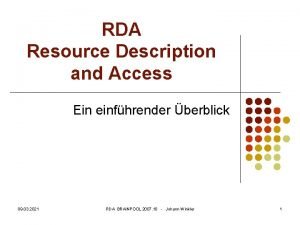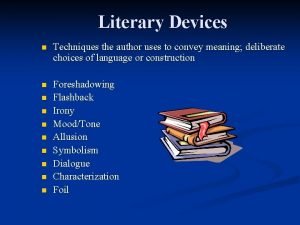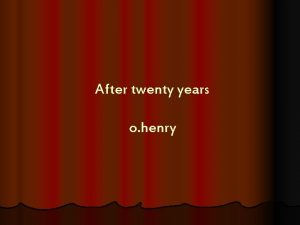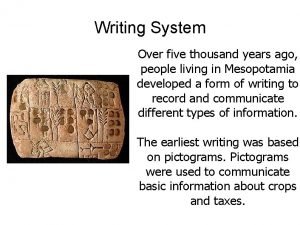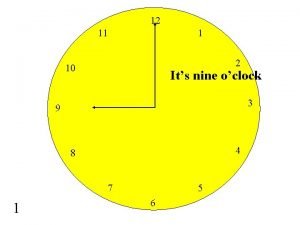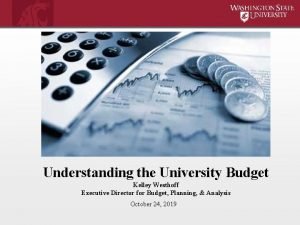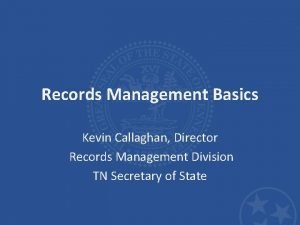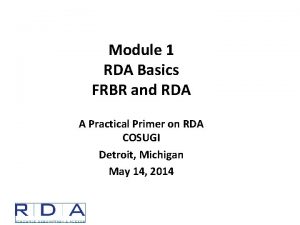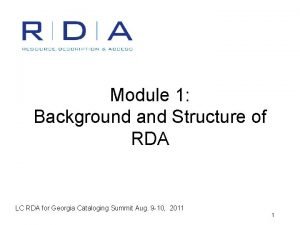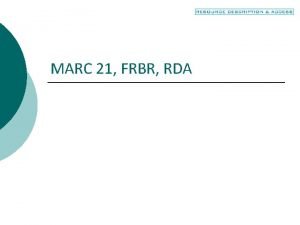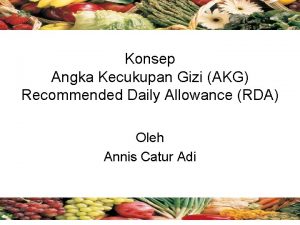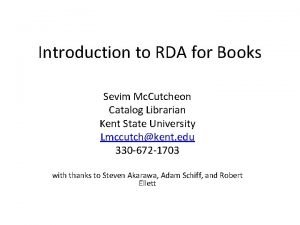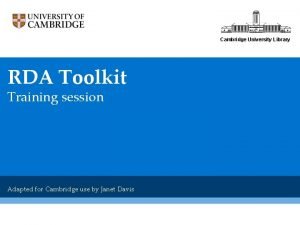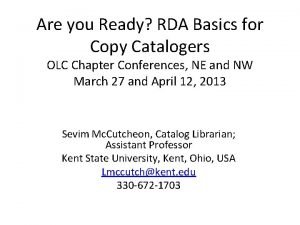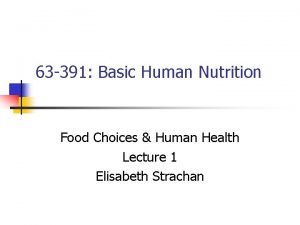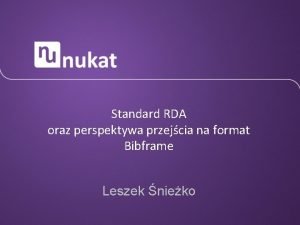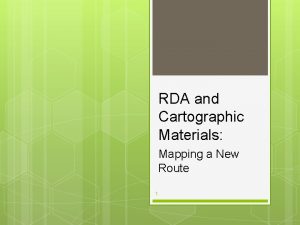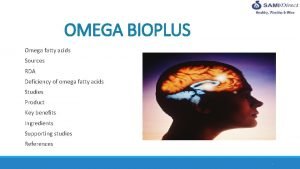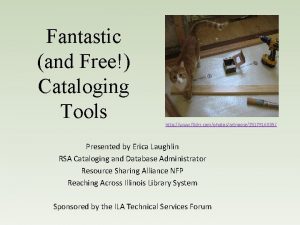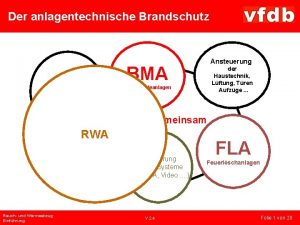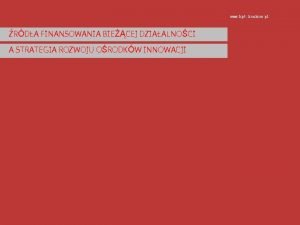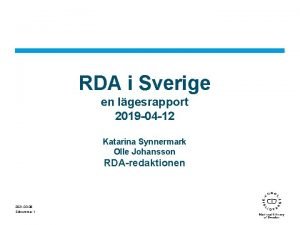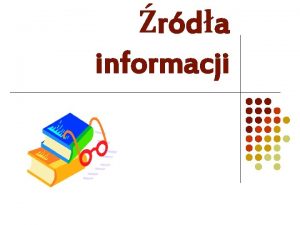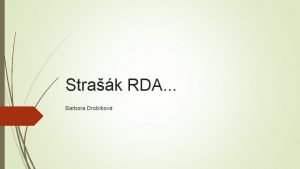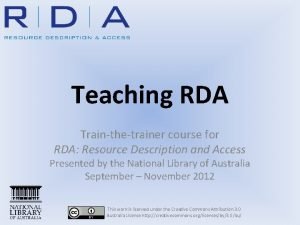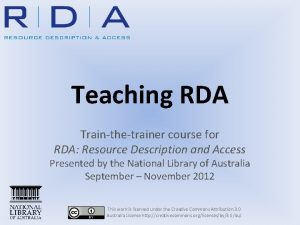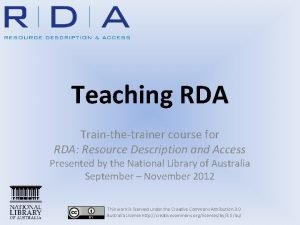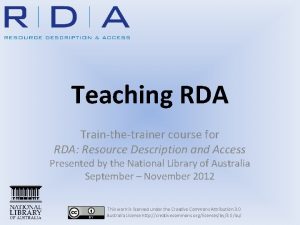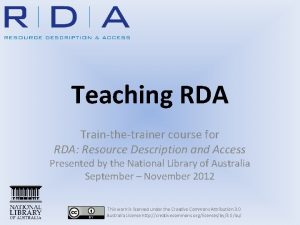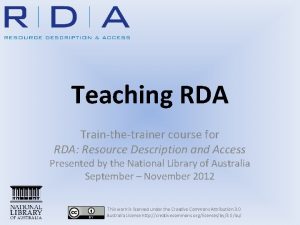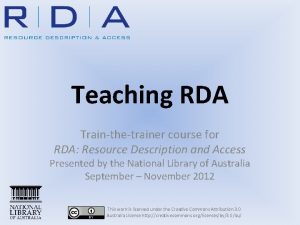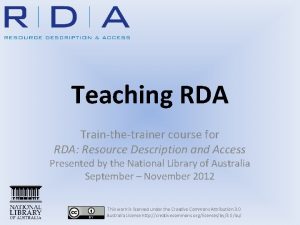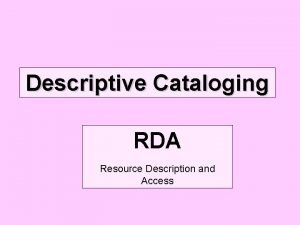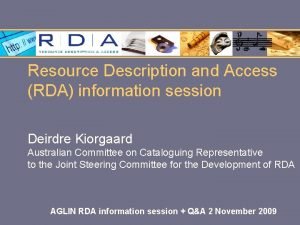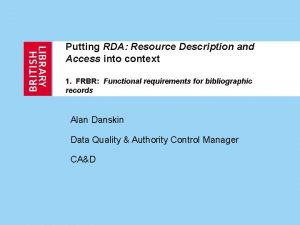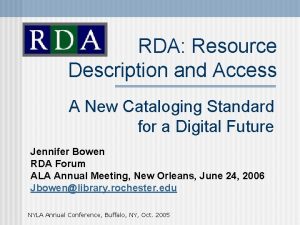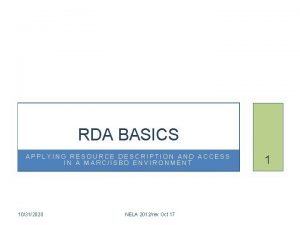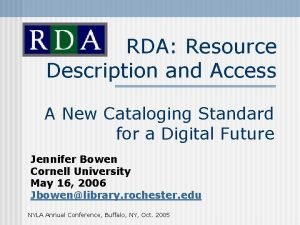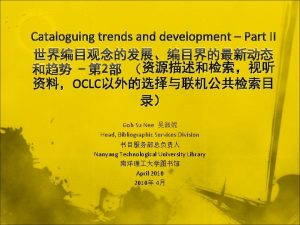Five years after RDA Resource Description and Access













![No GMD? Now what? AACR 2 $h [GMD] RDA – 33 X fields 336 No GMD? Now what? AACR 2 $h [GMD] RDA – 33 X fields 336](https://slidetodoc.com/presentation_image_h/d70f740c36fe8627e7201cd61768f8f5/image-14.jpg)



























- Slides: 41

Five years after RDA (Resource Description and Access) implementation: Are the users better off? Irina Kandarasheva Columbia University Libraries 4 th Academic Libraries Invitational Conference April 27, 2018

Summary of topics covered: �Brief review of RDA �RDA test and implementation �Major differences between RDA and AACR 2 �Impact on OPACs �Columbia University Libraries experience �What happens next?

RDA – what is it? �RDA = Resource Description and Access �Developed by Anglo-American national libraries and associations to be used internationally �Replaces AACR 2 cataloging �Based on FRBR (Functional Requirements for Bibliographic Records) and FRAD (Functional Requirements for Authority Data) �Released 2010 with web based RDA Toolkit, implemented after a test pilot in March 2013

Road to RDA: the need for new cataloging code �More resources – in numbers and types �More records shared internationally �More loading of large files �More demand for record enrichment �Metadata is omnipresent and encoded in different ways �More data sharing online

RDA/FRBR principles: focus on the user �“Find” – find resources that correspond with user’s search criteria �“Identify”- confirm that the resource sought corresponds with the resource described, and distinguish between resources with similar characteristics �“Select” – select the resource appropriate for the user’s needs �“Obtain” – how to acquire or access the resource

What is FRBR? Functional Requirements for Bibliographic Records FRBR is organized into groups of entities which have attributes. �Group 1 entities are work, expression, manifestation, and item �Group 2 entities are persons and corporate bodies �Group 3 entities are the subjects of the works, and they can be concepts, objects, events, or places

FRBR Group 1 Entities

Example of FRBR relationships �Work - “War and peace” novel written by Leo Tolstoy, has been reprinted, translated, annotated, adapted, made into movies, etc. Abstract idea or literary creation of Tolstoy. �Expression - in FRBR terms all editions of “War and peace”, including the first one published in 1869, are realization of the work. All translations, illustrated editions, and editions with new forwards are new expressions. �Manifestation - physical embodiment of an expression: e. g. hardcover and paperback, kindle editions, audio editions. �Item - a particular copy of the book you buy, download, or borrow from a library.

“War and Peace”

A little bit of terminology �FRBR (Functional Requirements for Bibliographic Records) - conceptual model �RDA/AACR 2 (Resource Description & Access) and (Anglo -American Cataloging Rules) – content standard �ISBD (International Standard Bibliographic Description) – display format �MARC/MARC 21 (MAchine Readable Cataloging Record) – communication standard

RDA implementation �Mostly focused on training �Adjustments to online catalogs �Vendor services �Creating authority records more time consuming �Hybrid AACR 2 -RDA records, local policies

Some major differences between AACR 2 and RDA �Changes in terminology �General material designator [GMD] �Relationships �Representing multiple authors �“Take what you see” �Richer authority records

Changes in terminology: AACR 2 > RDA �Heading > Authorized access point �Author, composer, etc. > Creator �Main entry > Preferred title + Authorized access point for creator (if appropriate) �Physical description > Carrier description �See reference > Variant access point �See also reference > Authorized access point
![No GMD Now what AACR 2 h GMD RDA 33 X fields 336 No GMD? Now what? AACR 2 $h [GMD] RDA – 33 X fields 336](https://slidetodoc.com/presentation_image_h/d70f740c36fe8627e7201cd61768f8f5/image-14.jpg)
No GMD? Now what? AACR 2 $h [GMD] RDA – 33 X fields 336 – Content type 337 – Media type 338 – Carrier type $h [audiobook] 336 spoken word |2 rdacontent 337 audio |2 rdamedia 338 audio disc |2 rdacarrier

GMD replaced �Slide

Relationships designators in RDA �Slide �P. 229

�Slide

“Take what you see” �Lack of familiar abbreviations �Different way to treat typos and errors �Capitalization �Place of publication, publisher information �Dates, copyright date

Lack of familiar abbreviations

Typos and errors in RDA

Publisher information

Dates, copyright date

RDA authority records �As in bibliographic records less abbreviations in authority records �Update of hundreds of thousands of authority records to comply with RDA �Optional addition of a large amount of new information: occupation, gender, residence, education, etc. �While not visible to users, new information helpful for differentiation of similar names and corporate bodies, potential for expanding the search functionality of library catalogs in the future



Columbia University Libraries experience with RDA �One of the early test sites, early implementation �Strong in-house training program (learning RDA by teaching it) �Copy and original cataloging �Involvement with linked data projects

Columbia University Libraries RDA Wiki

Columbia University Libraries RDA local policies and procedures

RDA at Columbia University Libraries �Display conventions for CLIO (Columbia University Libraries OPAC) �Relationship designators (author, editor, translator->one search) �Labels to express 7 xx relationships: Includes, Also listed under �What facets to expose, question of formats �Decisions on authority records and headings display

Searching CLIO using RDA

RDA related indexing choices



Linked data

From cataloging to linking

Linked data in Libraries Slide of Teodora Petkova

BIBFRAME (Bibliographic Framework initiative) model

MARC and BIBFRAME comparison

Some latest RDA developments: �RDA (Resource Description & Access) and LRM (Library Reference Model) �RDA Toolkit restructure and redesign (3 R) project �Translation of RDA to other languages �Linked data projects

Conclusions: �RDA provides more flexible standard which could be used beyond the traditional catalog �Removes cultural bias to enable global use �Supports clustering of bibliographic records to show relationships between resources and their creators to make users more aware of different editions, translations, and formats �RDA provides guidance for describing digital resources, optimizes library catalogs, and improves searching and browsing for users

Questions? ink 2@columbia. edu
 Resource description and access
Resource description and access And all its aching joys are now no more
And all its aching joys are now no more After me after me after me
After me after me after me John 14:1
John 14:1 Four scores and seven years ago
Four scores and seven years ago Goat years to human years
Goat years to human years 300 solar years to lunar years
300 solar years to lunar years After twenty years literary devices
After twenty years literary devices After twenty years by o henry
After twenty years by o henry Hen duo qian
Hen duo qian We have been running the youth camp ... five years.
We have been running the youth camp ... five years. Why did the barley sign change shape
Why did the barley sign change shape Resource allocation vs resource leveling
Resource allocation vs resource leveling Perbedaan resource loading dan resource leveling
Perbedaan resource loading dan resource leveling 5 elements and 5 senses
5 elements and 5 senses Terminal access controller access-control system
Terminal access controller access-control system Terminal access controller access-control system
Terminal access controller access-control system Twenty past two
Twenty past two Five of five
Five of five Macbeth act five scene five
Macbeth act five scene five What is rda?
What is rda? Vitamin b deficiency tongue
Vitamin b deficiency tongue Rda wsu chart
Rda wsu chart Rda callaghan
Rda callaghan Rda frbr
Rda frbr Structure of rda
Structure of rda Frbr examples
Frbr examples Rda gizi
Rda gizi What is rda?
What is rda? Rda toolkit
Rda toolkit Que significa rda en nutricion
Que significa rda en nutricion What is rda?
What is rda? Dri vs rda
Dri vs rda Rda sverige
Rda sverige Rda format
Rda format Rda road map
Rda road map Omega 6 rda
Omega 6 rda Rda cataloging cheat sheet
Rda cataloging cheat sheet Rda haustechnik
Rda haustechnik Rda coaching pathway
Rda coaching pathway Kraków rda
Kraków rda Rda sverige
Rda sverige
